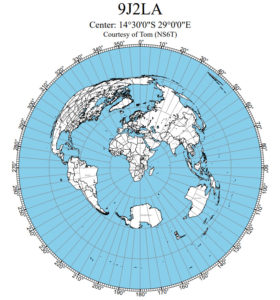| 9J2LA Frequencies (updated March 03de. 2020) All frequencies are +- QRM |
| CW | SSB | RTTY | FT8 |
| 1826,5 (1) | —– | —– | 1836 / 1908(2) |
| 3524 | —– | —– | 3567 |
| 7024 | 7082 | 7045 | 7060 |
| 10124 | —— | 10142 | 10140 |
| 14024 | 14185 | 14082 | 14086 |
| 18074 | 18140 | 18096 | 18104 |
| 21024 | 21295 | 21082 | 21095 |
| 24894 | 24955 | 24912 | 24918 |
| 28024 | 28495 | 28082 | 28095 |
| 50104 | —— | —– | 50313 |
Any station located in AF(rica) and/or OC(eania) may call regardless of the region we are currently working/calling for.
(1) 160m: 1826.5 Khz lsn dwn for JA, up for EU, NA and other continents.
(2) 160m FT8, QSX 1908 for JA.
9J2LA TEAM on FT8
We plan to use FT8 as the primary data mode. We will use FT8 DXpedition mode, operating as the Fox.
You must be using WSJT-X v 2.0 in Hound mode to achieve a QSO.
Here is a guide for operating FT8 DXpedition mode : https://physics.princeton.edu/pulsar/k1jt/FT8_DXpedition_Mode.pdf
If you hear us on the normal FT8 frequencies we will not be using DXpedition mode and only work one station at the time.
If the number of callers is high we will announce a QSY to our DXpedition frequencies.
Below are the steps to work 9J2LA on FT8:
Ensure you have the latest full version 2.0 of the WSJT-X software installed on your computer
Ensure your computer clock is accurate. Read the FT8 help files. Select the Hound role:
Call 9J2LA only after you decode our CQ message. Simply double-click on our callsign in the Band Activity window and the software will create the correct message
with which to call us and start transmitting. You will need to periodically press ‘Enable TX’ from time to time to keep transmitting in the pileup.
The DXpedition station will send a CQ message from time to time so that you should not have to wait long to select the callsign.
Call as long as you need to work us. We will be operating often with ‘multiple streams’, and may be conducting several QSOs simultaneously.
Once you decode the message ‘<Your Call> 9J2LA … RR73’ (also called the TX4 message) from us, you should log the QSO. Keep calling until you complete this step.
Do not make duplicate QSOs on a band . If your callsign does not appear in the log updates to ClubLog, feel free to repeat a QSO.
The following are some general practices that the 9J2LA team will follow.
We will use directional CQs. Please follow our instructions.
If demand for FT8 QSOs is low or band conditions are poor, we will operate in normal FT8 mode on the standard FT8 frequencies.
NS6T.Net provides personalized azimuthal maps and we’ve produced one for 9J2LA, available as a PDF, below.
Azimuthal Map, courtesy NS6T.net – Click for PDF

